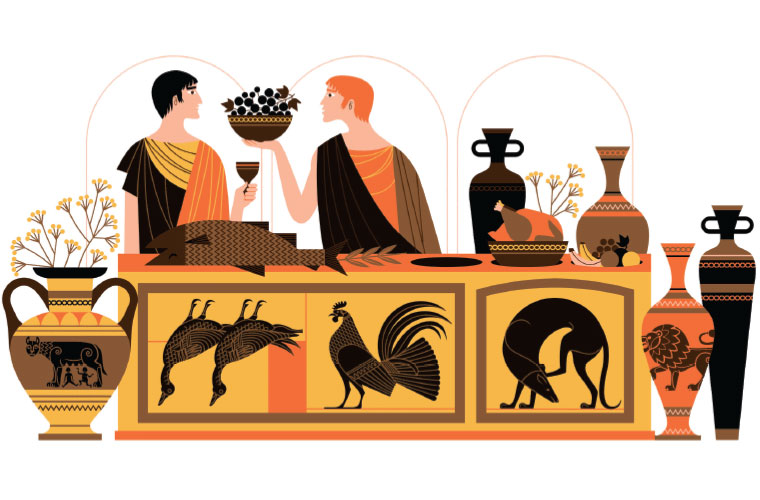

Mt. Vesuvius erupted in 79 CE, burying the city of Pompeii under a mass of ash and pumice, and creating a time capsule of life in an early Imperial Roman town that has been a subject of fascination since it was rediscovered in the 16th century. Some two-thirds of the site has been excavated thus far, and one thing that’s clear is that average Pompeiians dined out—a lot.
On a recent visit to the Archaeological Park of Pompeii, I walked along the streets of the 160-acre site, looking for evidence of its ancient food and wine culture. At the entrances to dozens of buildings, I spotted L-shaped counters with multiple round openings. Some of the counters have been partially destroyed, revealing that beneath those openings are large ceramic jars, or dolia, around which the counter was built. It’s the ancient version of a lunch counter—though dinner would have been served as well.
Archaeologists have counted more than 160 food and beverage shops in Pompeii, this in a town with an estimated population of 12,000 to 20,000 at the time of the eruption. To put that in perspective, New Paltz, a college town in New York’s Hudson River Valley, today has a population of 14,000 with 100 active liquor licenses. In Pompeii, different names applied to these establishments—tabernae, popinae, cauponae—depending on their size, whether they offered cooked food and if they also functioned as inns. For simplicity’s sake, and because I’m no scholar, let’s call them “taverns.” The ubiquity of these public taverns suggests that dining culture had evolved dramatically since the communal gatherings of the urban elite in fifth-century BCE Crete, as described by Professor Donald Haggis. In Pompeii, wealthy people dined in their large, lavishly decorated homes, like the House of Octavius Quartio, where the family and their guests lounged on triclinia (three-sided couches), their dinners cooked and served by people they had enslaved. Taverns were largely for the lower classes, especially those whose homes lacked the space or the facilities to cook for themselves.
“At Pompeii, it was the poor who ate out.” —Mary Beard, The Fires of Vesuvius
Pompeiians would have run into a riot of color when going out to the tavern, the various establishments competing for their attention. There are still remnants of graffiti, advertisements and election posters on exterior walls, such as the one which translates loosely as “Asellina [perhaps the female bar owner] and her girls [waitresses?] suggest you vote for Lolium.” Interior walls show the remains of frescoes, some depicting scenes of tavern life such as men playing a dice game, others indicating the kind of bawdy activities associated with prostitution. Some of the counters are decorated with multi-colored pieces of marble, others with simple paintings. A recently excavated tavern in Regio V (one of eight sectors of the city) sports a bar with brilliantly colored images of a rooster, ducks and a dog on a leash. A duck bone was found in one of the dolia.
The menus at Pompeii’s taverns evidently varied from one to the next and depended upon the season, but locals could find quite a variety of foods, including beans, lentils, nuts, fruit, cheese, snails, fish, duck, chicken and pork. Some taverns offered foods spiced with peppercorns, sesame, cumin and coriander. Patrons of the larger taverns could have enjoyed their meals inside, but some of the spaces are so tiny that they could barely accommodate one person behind the counter. Customers would have had to stand on the sidewalk. They would have either taken their food and drink home or consumed it next to the bar—a scene that evokes comparisons to modern-day Italian cities, where it is common to see lively crowds drinking and conversing on the street outside popular bars.
And, of course, there was wine, as is clear from the amphoras found in many of the bars. Campania, the region around Pompeii, was a source of some of Rome’s most renowned wines, including Falernian, which came from vineyards just up the coast from Pompeii. Dr. Emlyn Dodd, an archaeologist at The British School at Rome and author of a recent book on ancient Roman wine, says that the evidence suggests much of the wine consumed in Pompeii was local up until about 50 CE, but then things started to shift, with imported wines becoming popular. “There is evidence of wines from across the Mediterranean—for example, the House and Bar of Amarantus has at least thirty wine amphoras from Crete (perhaps a sweet passum wine), as well as others from Kos, Rhodes, Turkey and Sicily.”
Wines of varying quality were offered, with the different prices written right on the walls. At Herculaneum, a smaller town about ten miles away that was also destroyed in 79 CE, a fresco on the wall outside a bar depicts four amphoras of different colors, each representing a different wine with prices underneath. The most expensive one is twice the price of the cheapest. At a price equal to the typical wage of a Roman soldier at the time, this may have been an early cult wine…or maybe it was just legitimately higher quality. One way or another, at least some first-century Pompeiians were discerning about their wine.
is the Italian wine editor at Wine & Spirits magazine.
This story appears in the print issue of Summer 2022.
Like what you read? Subscribe today.



















